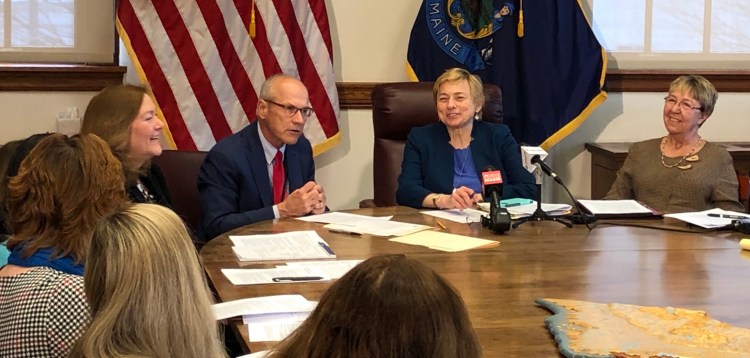AUGUSTA — The Mills administration plans to begin placing the overdose reversal drug Narcan in public buildings as part of the state’s efforts to address the opioid crisis.
Gordon Smith, Maine’s newly appointed director of opioid response, discussed the plans Wednesday during the first meeting of Gov. Janet Mills’ Prevention and Recovery Cabinet, which is tasked with helping coordinate the state’s response to a drug crisis that is killing one Mainer per day.
The administration currently is distributing 35,000 doses of the overdose reversal drug Narcan, also known as naloxone. Smith said the administration plans to install boxes containing naloxone – dubbed NaloxBoxes – in public buildings, often near automated external defibrillator, or AED, devices used to revive individuals in cardiac arrest.
In some other states, such boxes are being installed in public places, with packaged components that can be used by anyone and do not require special training to administer.
“We will start slow with public buildings,” Smith said. “We also think it will help to decrease stigma when we’ve got Narcan all over the place and people will begin to understand this is a chronic disease.”
Speaking at the start of the gathering, Mills emphasized the many facets of the addiction crisis, which is affecting the health and safety of the state’s workforce, violent crime rates, schools and homes, as older Mainers suddenly find themselves raising grandchildren.
Mills and other speakers said part of the effort will be to increase transparency about the addiction crisis in hopes of fostering public engagement and reducing the stigma associated with substance use disorders.

NaloxBox is an opioid intervention kit that will be placed in public buildings as part of Maine’s efforts to address the opioid crisis. Photo courtesy of Amos House
“We want to break down the silos of communication,” Mills said. “We want to break down the silos of information and share as much as we can about what’s going on out there and what we can do better to stop this epidemic, to stop it in its tracks.”
Mills announced the Prevention and Recovery Cabinet in February in an executive order that also created the position of a director of opioid response within the governor’s office. Mills then tapped Smith – a longtime executive and lobbyist for the Maine Medical Association heavily involved in policy discussions over the opioid crisis – to serve as the director and to help lead the Cabinet.
There were 282 overdose deaths in the state during the first nine months of 2018 in Maine, according to the attorney general’s office. While figures for the full year were expected to be released soon, the data for the first three quarters of the year suggest that drug deaths had declined by roughly 5 percent but still were expected to exceed one death per day for the year as the years-long opioid crisis drags on.
As in recent years, the vast majority of those deaths were expected to be caused by heroin, fentanyl or other opioids.
The opioid cabinet is composed of the commissioners of the state’s 14 departments plus representatives of the attorney general’s office, the judicial system, a person in recovery from addiction, and a family member of a person struggling with substance use.
During Wednesday’s meeting, each member discussed how the opioid crisis is affecting the work of their respective agencies and how staff members are responding.
Marine Resources Commissioner Patrick Keliher, for instance, said the first directive he received from Mills was to institute a policy to ensure Marine Patrol officers have access to and can use Narcan.
“Maine Marine Patrol comes into contact with addicted fishermen on a daily basis,” Keliher said. “We license over 10,000 fishermen at the Department of Marine Resources. We have a multibillion-dollar industry that we support, and opioid addiction has, sadly, become a major component of fisheries.”
Keliher said the crisis is affecting workforce development and even compliance with fisheries regulations.
The Maine Department of Corrections is working to launch a medication-assisted treatment pilot project at the Maine Correctional Facility in Windham, the Bolduc Correctional Facility in Warren and the Southern Maine Women’s Reentry Center in Windham. The goal of the pilot program is to offer medication-assisted treatment at the jails and arrange for a “hand-off” to a similar facility in the community for after individuals are released.
Chief Justice Leigh Saufley of the Maine Supreme Judicial Court said “we have to stop thinking of addiction recovery and addiction prevention as limited to a particular area of government.”
“The opioid addiction problem affects every aspect of government and it affects everything that goes on in the court system,” Saufley said. “It’s affecting work and families and housing.”
The Maine Department of Professional and Financial Regulation has seen a surge in applications for drug and alcohol counselors as well as social workers amid the ongoing crisis. And the Department of Transportation suspects that a severe shortage in some laborers is being caused by the addiction crisis.
Maine Health and Human Services Commission Jeanne Lambrew said the crisis “cuts across all of our work.” In addition to distributing the 35,000 doses of naloxone, Lambrew said, DHHS is working with schools on education and prevention programs while working to increase access to treatment, in part by expanding Medicaid.
“We are treating this crisis with the urgency that it deserves,” Lambrew said.
Mills ended the meeting by telling the group that “we’re going to get it done” by, in part, knocking down the stigma associated with substance use disorders by getting people to talk openly about the issue.
“The first step to beating back this problem is to get a better attitude, to make positive change, and that’s what we’re all about,” Mills said.
Send questions/comments to the editors.



